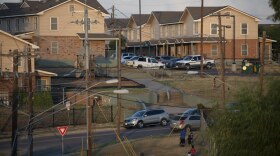The City of Austin has spent almost eight years and roughly $11 million rewriting its land use code; that’s the set of rules dictating what you can build in the city and where you can build it.
Much of the code can be mystifying to those outside the planning or building world, with terms like setback (how far back from the road you can build a house) and FAR (the ratio of floor space to area of your land).
As the proposed new code makes its way through city commissions and to the council members for an initial vote in December, here are five concepts to help you better understand what’s being talked about:
'Missing Middle' Housing
The term refers to buildings with anywhere from two to 50 housing units – in general, anything between a single detached home and a big apartment building. This can mean duplexes, townhomes and small apartment complexes. (Here’s a KUT explainer on "missing middle" housing from 2017.)
These types of homes offer alternatives for people who don't want to live in a large apartment complex and can't afford a detached home. The "missing" refers to the fact that they are missing from many U.S. cities because land use codes have made this type of housing hard to build. Architects in Austin worried previous iterations of a new code didn’t allow for enough missing middle housing.
What City Council wants to see: More missing middle housing allowed to be built close to busy roads and/or near public transportation options; in other words, in transition areas (see below). The council says roughly one-third of possible new housing should be missing middle.
Transition Areas
These are the parts of the city where staff is proposing new missing middle housing. The idea is to start with a busy street – North Lamar, Enfield and South First, for example – where you will find large apartment complexes. As you drive into a neighborhood from the street, the housing becomes less dense, moving from small apartment buildings and duplexes to single detached homes.

What City Council wants to see: The City Council asked staff to write a code in which 75% of possible new housing would be built within a half-mile of public transportation options.
Accessory Dwelling Units (ADUs)
These are also called garage apartments or granny flats; in other words, a smaller house or part of a house on a single-family piece of land. People who support the building of more housing in Austin say ADUs are an easy way to build more in neighborhoods with single detached homes by "filling in" unused land.
What City Council wants to see: To ease restrictions on building ADUs in more parts of the city and to allow the building of an ADU within an existing structure – in other words, to section off a part of your house as a second unit.
Parking Minimums (And Maximums)
When you build something in Austin, there’s a minimum amount of parking you have to include alongside it – for example, a builder must provide at least two parking spots per single detached house. The city doesn’t currently enforce parking maximums.
What City Council wants to see: Do away with minimum parking requirements within a quarter mile of busy roads or public transit centers and consider creating maximum parking limits.
Preservation Incentive
To discourage the demolition of old housing, which often can be cheaper than new homes, the city would relax building regulations on land where the owner has agreed to build around the existing home.
What City Council wants to see: Council wants to find ways to preserve existing housing, especially unsubsidized affordable housing.
Correction: A previous version of this story incorrectly defined FAR.






